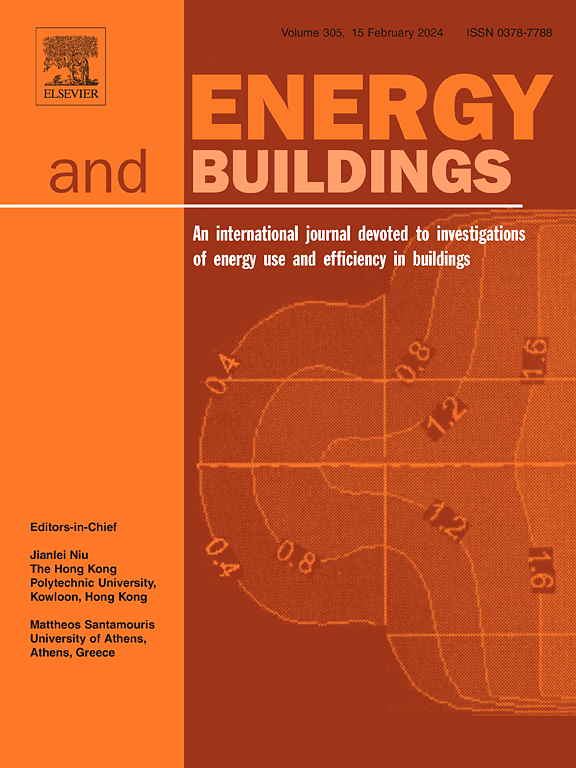Sex difference in body temperature and thermal perception during nighttime sleep: A time series analysis
IF 6.6
2区 工程技术
Q1 CONSTRUCTION & BUILDING TECHNOLOGY
引用次数: 0
Abstract
Sex difference stands as a crucial factor necessitating consideration in personalized sleeping thermal environment control. However, there has been little exploration about sex differences in body temperature and thermal perception during sleep. Based on data from a winter sleep experiment (16, 20, 24°C) involving 14 young participants (7 males, 7 females), a time series analysis of the dynamic body temperature rhythms throughout the night was conducted, revealing sex-specific patterns in local skin temperature and core body temperature. Additionally, the sex difference in the thermal perception votes recalled by subjects after waking was analyzed. The results showed that: (1) For both sexes, the skin temperatures reached to stable condition in 2–3 h after getting into bed, and core temperatures changed over the entire night. The average value and maximum increase value of overnight skin temperature at distal parts (hands and feet) were prone to sex differences, which become more pronounced at lower ambient temperature. (2) Females’ core body temperature was generally higher than that of males at the same time points. Due to the influence of estrogenic hormones, the maximum reduction in core body temperature during sleep was typically smaller in females than in males, with significant differences (p < 0.05) observed under the 16 °C and 24 °C conditions. (3) Females exhibited higher psychological demands for the sleeping thermal environment than males. Males reported feeling more comfortable than females in the 16 °C and 20 °C conditions. Additionally, males generally showed greater acceptance and satisfaction with all thermal environments compared to females. Overall, the creation of personalized sleeping thermal environments must account for sex differences in both skin temperature and core body temperature. This study provides a theoretical foundation for personalized sleeping thermal environment design from the perspective of thermo-physiology.
夜间睡眠中体温和热感知的性别差异:时间序列分析
性别差异是个性化睡眠热环境控制中需要考虑的重要因素。然而,关于睡眠中体温和热感知的性别差异的研究却很少。基于14名年轻参与者(7男7女)冬季睡眠实验(温度分别为16、20、24°C)的数据,对整个夜间的动态体温节律进行了时间序列分析,揭示了局部皮肤温度和核心体温的性别特异性模式。此外,还分析了受试者清醒后回忆的热知觉投票的性别差异。结果表明:(1)两性皮肤温度在上床后2 ~ 3 h达到稳定状态,核心温度在整个夜间发生变化。远端部位(手和脚)夜间皮肤温度的平均值和最大升高值容易出现性别差异,环境温度越低,这种差异越明显。(2)在同一时间点,女性核心体温普遍高于男性。由于雌激素的影响,女性在睡眠期间核心体温的最大下降幅度通常小于男性,差异显著(p <;在16°C和24°C条件下观察到0.05)。(3)女性对睡眠热环境的心理需求高于男性。据报道,在16°C和20°C的环境中,男性比女性感觉更舒适。此外,与雌性相比,雄性对所有热环境都表现出更高的接受度和满意度。总的来说,个性化睡眠热环境的创造必须考虑到皮肤温度和核心体温的性别差异。本研究从热生理角度为个性化睡眠热环境设计提供了理论基础。
本文章由计算机程序翻译,如有差异,请以英文原文为准。
求助全文
约1分钟内获得全文
求助全文
来源期刊

Energy and Buildings
工程技术-工程:土木
CiteScore
12.70
自引率
11.90%
发文量
863
审稿时长
38 days
期刊介绍:
An international journal devoted to investigations of energy use and efficiency in buildings
Energy and Buildings is an international journal publishing articles with explicit links to energy use in buildings. The aim is to present new research results, and new proven practice aimed at reducing the energy needs of a building and improving indoor environment quality.
 求助内容:
求助内容: 应助结果提醒方式:
应助结果提醒方式:


